仁爱版八年级英语上册Unit4Topic2SectionD优质教案
- 格式:doc
- 大小:82.01 KB
- 文档页数:10
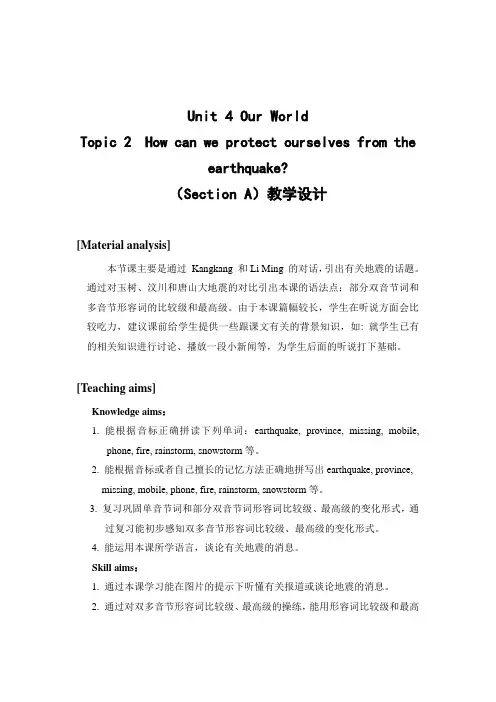
Unit 4 Our WorldTopic 2 How can we protect ourselves from theearthquake?(Section A)教学设计[Material analysis]本节课主要是通过Kangkang 和Li Ming 的对话,引出有关地震的话题。
通过对玉树、汶川和唐山大地震的对比引出本课的语法点:部分双音节词和多音节形容词的比较级和最高级。
由于本课篇幅较长,学生在听说方面会比较吃力,建议课前给学生提供一些跟课文有关的背景知识,如: 就学生已有的相关知识进行讨论、播放一段小新闻等,为学生后面的听说打下基础。
[Teaching aims]Knowledge aims:1. 能根据音标正确拼读下列单词:earthquake, province, missing, mobile,phone, fire, rainstorm, snowstorm等。
2. 能根据音标或者自己擅长的记忆方法正确地拼写出earthquake, province,missing, mobile, phone, fire, rainstorm, snowstorm等。
3. 复习巩固单音节词和部分双音节词形容词比较级、最高级的变化形式,通过复习能初步感知双多音节形容词比较级、最高级的变化形式。
4. 能运用本课所学语言,谈论有关地震的消息。
Skill aims:1. 通过本课学习能在图片的提示下听懂有关报道或谈论地震的消息。
2. 通过对双多音节形容词比较级、最高级的操练,能用形容词比较级和最高级谈论有关自然灾害的话题。
3. 能正确朗读课本的文本材料,读懂报道地震的消息。
4. 能正确地用形容词的比较级和最高级造句。
Emotional aims:通过对地震的学习,让学生感受生命的可贵,懂得珍惜自己和他人的生命。
[ The key points and difficult points]Key points:1. 学习双多音节形容词的比较级和最高级的变化规则。

八年级上册Unit 4 Our worldTopic 2 How can we protect ourselves from the earthquake?一.重点句型:Section A1.A terrible earthquake struck Qinghai.一场可怕的地震袭击了青海。
strike意为“侵袭,爆发”,过去式struck。
The lightning struck again. 雷电再次闪击。
2.Many buildings fell down.Some people died and many people are missing. 许多建筑倒塌,很多人死亡,还有许多人失踪。
fall down 倒塌,跌倒,下落;I fell down and hurt my knee. 我摔倒弄伤了膝盖。
3. And I know that there were anther two terrible earthquakes in China. 我还直到发生在中国的另外两次严重的地震。
another意为:“又一,再一,另一(事物或人)”,后面可接单数名词、数字加复数的名词。
another + 数字+ 复数名词= 数字+more +复数名词;Would you like another apple?你想再来一个苹果吗?another 3 hours = 3 more hours 另外三个小时;4. I’m very sorry to hear that. 听到这个消息很遗憾。
表达听者难过、同情或抱歉的心情。
此句是表示关心的句子。
-----I have a bad cold today. 今天我得了重感冒。
----- I’m very sorry to hear that. 听到这个消息很遗憾。
5. I think the Wenchuan earthquake in 2008 was more serious than this one,but theTangshan earthquake in 1976 was the most serious. 我认为2008年的汶川地震比这个地震要严重,但是1976年的唐山大地震是最严重的。

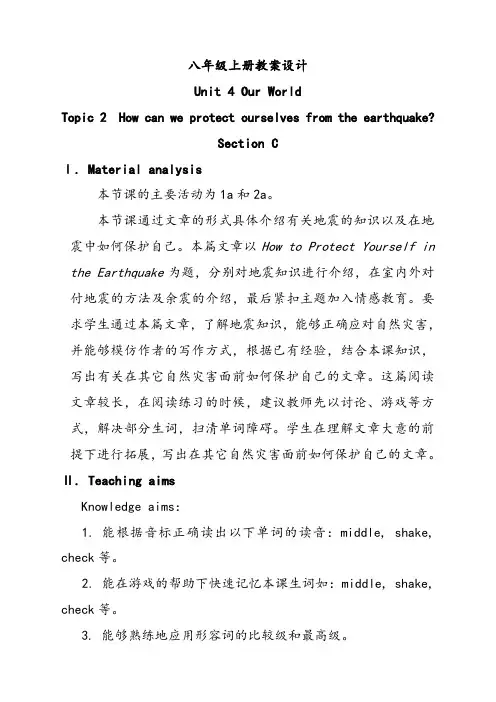
八年级上册教案设计Unit 4 Our WorldTopic 2 How can we protect ourselves from the earthquake?Section CⅠ. Material analysis本节课的主要活动为1a和2a。
本节课通过文章的形式具体介绍有关地震的知识以及在地震中如何保护自己。
本篇文章以How to Protect Yourself in the Earthquake为题,分别对地震知识进行介绍,在室内外对付地震的方法及余震的介绍,最后紧扣主题加入情感教育。
要求学生通过本篇文章,了解地震知识,能够正确应对自然灾害,并能够模仿作者的写作方式,根据已有经验,结合本课知识,写出有关在其它自然灾害面前如何保护自己的文章。
这篇阅读文章较长,在阅读练习的时候,建议教师先以讨论、游戏等方式,解决部分生词,扫清单词障碍。
学生在理解文章大意的前提下进行拓展,写出在其它自然灾害面前如何保护自己的文章。
Ⅱ. Teaching aimsKnowledge aims:1. 能根据音标正确读出以下单词的读音:middle, shake, check等。
2. 能在游戏的帮助下快速记忆本课生词如:middle, shake, check等。
3. 能够熟练地应用形容词的比较级和最高级。
4. 能够用形容词的比较级和最高级谈论自然灾害的程度。
Skill aims:1. 能基本听懂本课文本材料,能写出简单的介绍如何在发生自然灾害的时候保护自己的文章。
2. 能流利地和他人谈论在自然灾害中如何保护自己。
3. 能读懂介绍自然灾害的文章,以及相应的保护措施。
4. 能正确模仿本课课文,有条理地写出在自然灾害中如何保护自己的措施。
Emotional aims:1. 通过对本课的学习,学生能够明白:遇到困难应该沉着冷静。
2. 在自己的能力范围之内,帮助别人。
Ⅲ. The key points and difficult pointsKey points:1. 学习在地震中如何保护自己的知识。
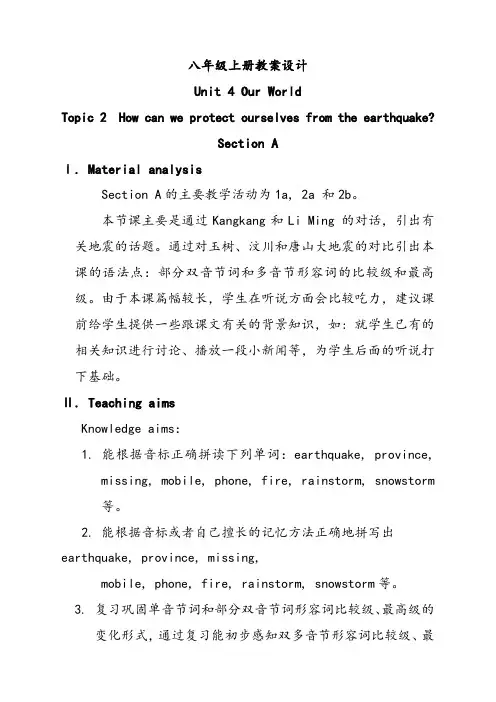
八年级上册教案设计Unit 4 Our WorldTopic 2 How can we protect ourselves from the earthquake?Section AⅠ. Material analysisSection A的主要教学活动为1a, 2a 和2b。
本节课主要是通过Kangkang和Li Ming 的对话,引出有关地震的话题。
通过对玉树、汶川和唐山大地震的对比引出本课的语法点:部分双音节词和多音节形容词的比较级和最高级。
由于本课篇幅较长,学生在听说方面会比较吃力,建议课前给学生提供一些跟课文有关的背景知识,如: 就学生已有的相关知识进行讨论、播放一段小新闻等,为学生后面的听说打下基础。
Ⅱ. Teaching aimsKnowledge aims:1. 能根据音标正确拼读下列单词:earthquake, province,missing, mobile, phone, fire, rainstorm, snowstorm等。
2. 能根据音标或者自己擅长的记忆方法正确地拼写出earthquake, province, missing,mobile, phone, fire, rainstorm, snowstorm等。
3. 复习巩固单音节词和部分双音节词形容词比较级、最高级的变化形式,通过复习能初步感知双多音节形容词比较级、最高级的变化形式。
4. 能运用本课所学语言,谈论有关地震的消息。
Skill aims:1. 通过本课学习能在图片的提示下听懂有关报道或谈论地震的消息。
2. 通过对双多音节形容词比较级、最高级的操练,能用形容词比较级和最高级谈论有关自然灾害的话题。
3. 能正确朗读课本的文本材料,读懂报道地震的消息。
4. 能正确地用形容词的比较级和最高级造句。
Emotional aims:通过对地震的学习,让学生感受生命的可贵,懂得珍惜自己和他人的生命。
Ⅲ. The key points and difficult pointsKey points:1. 学习双多音节形容词的比较级和最高级的变化规则。
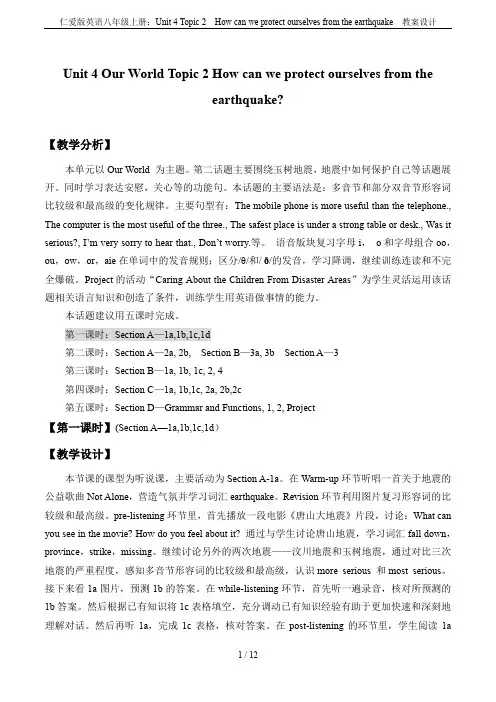
Unit 4 Our World Topic 2 How can we protect ourselves from theearthquake?【教学分析】本单元以Our World 为主题。
第二话题主要围绕玉树地震,地震中如何保护自己等话题展开。
同时学习表达安慰,关心等的功能句。
本话题的主要语法是:多音节和部分双音节形容词比较级和最高级的变化规律。
主要句型有:The mobile phone is more useful than the telephone., The computer is the most useful of the three., The safest place is under a strong table or desk., Was it serious?, I’m very sorry to hear that., Don’t worry.等。
语音版块复习字母i,o和字母组合oo,ou,ow,or,aie在单词中的发音规则;区分/θ/和/ ð/的发音,学习降调,继续训练连读和不完全爆破。
Project的活动“Caring About the Children From Disaster Areas”为学生灵活运用该话题相关语言知识和创造了条件,训练学生用英语做事情的能力。
本话题建议用五课时完成。
第一课时:Section A—1a,1b,1c,1d第二课时:Section A—2a, 2b, Section B—3a, 3b Section A—3第三课时:Section B—1a, 1b, 1c, 2, 4第四课时:Section C—1a, 1b,1c, 2a, 2b,2c第五课时:Section D—Grammar and Functions, 1, 2, Project【第一课时】(Section A—1a,1b,1c,1d)【教学设计】本节课的课型为听说课,主要活动为Section A-1a。
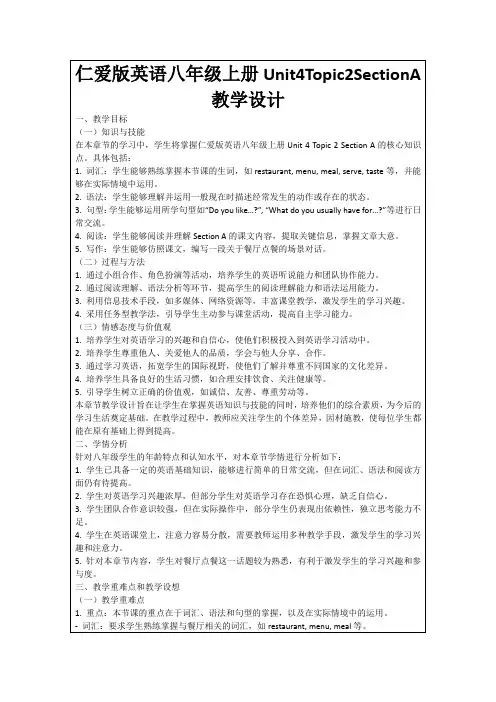
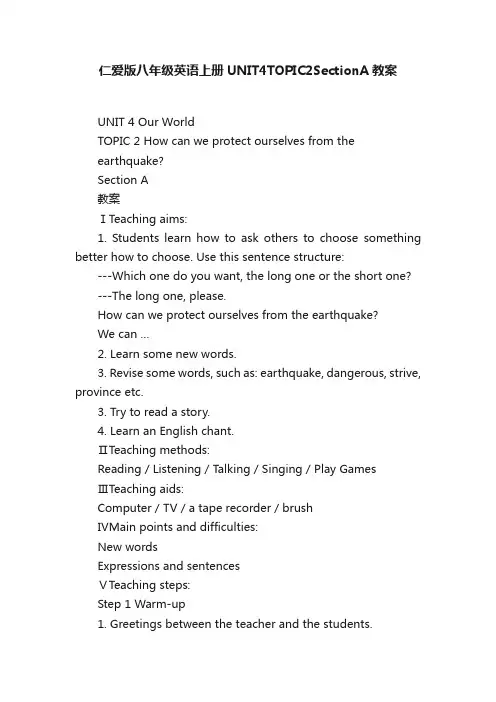
仁爱版八年级英语上册UNIT4TOPIC2SectionA教案UNIT 4 Our WorldTOPIC 2 How can we protect ourselves from theearthquake?Section A教案ⅠTeaching aims:1. Students learn how to ask others to choose something better how to choose. Use this sentence structure:---Which one do you want, the long one or the short one?---The long one, please.How can we protect ourselves from the earthquake?We can …2. Learn some new words.3. Revise some words, such as: earthquake, dangerous, strive, province etc.3. Try to read a story.4. Learn an English chant.ⅡTeaching methods:Reading / Listening / Talking / Singing / Play GamesⅢTeaching aids:Computer / TV / a tape recorder / brushⅣMain points and difficulties:New wordsExpressions and sentencesⅤTeaching steps:Step 1 Warm-up1. Greetings between the teacher and the students.2. Show the word cards which have been learned in the last class, let students read them quickly. Step 2 Presentation1. Teacher shows the students a map of Sichuan province, and asks them what it is. Then let students say their different points. Yes, This is Sichuan province. Then lead to read the word, province.2. This time teacher shows a picture of rock and a picture of pillow, and also asks them what it is, and if there is anything different between these two things, maybe the students will say one is hard and the other one is soft in Chinese, then the teacher writes these two words on the blackboard, hard and soft, and teach them how to pronounce these two words.3. Then teacher writes the word earthquake, lets students find the word related to this word, and after the students say out the word, teacher writes the word on the blackboard.4. This time, teacher asks the students to find some adjective to describe the earthquake, and write them on the blackboard. And at last, asks the students to copy them down on their own notebook, and read them out loudly.5. Teacher plays the tape of text, lets students try to understand its meaning, and then read after it.7. Then read the text again, and finish the questionnaires.Step 3 Consolidation1. Give the students three minutes to practice the conversation by themselves, then ask some pairs of students to act their dialogue in the class.2. Find some pairs of new words.3. Ask the students to find more new words to describe the earthquake.4. Play the tape again, this time ask the students to imitate after the tape.5. Finish the exercises in Part E, and then correct the answers in the class.Step 3 Consolidation1. Learn to say the chant in Part F.2. Do the exercises in the Workbook.3. Have a dictation.4. Listen to the tape and read it, try to understand the short essay and imitate the pronunciation and intonation.5. Let’s have fun.Homework1. Read the words and sentences of this Unit.2. Do some exercises in exercise books.。
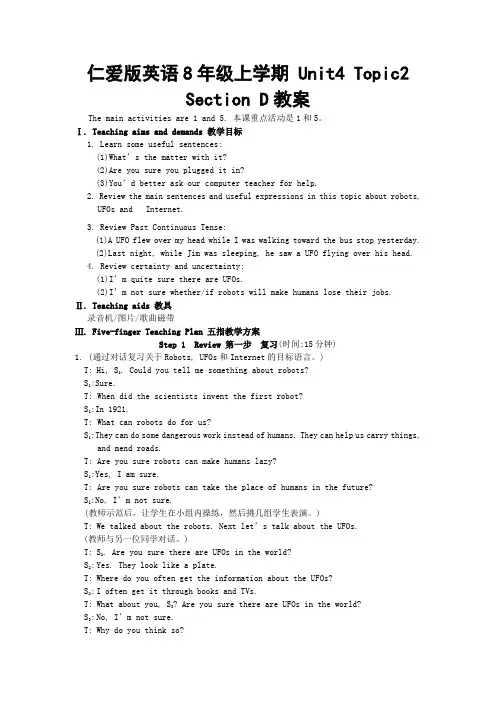
仁爱版英语8年级上学期 Unit4 Topic2Section D教案The main activities are 1 and 5. 本课重点活动是1和5。
Ⅰ. Teaching aims and demands 教学目标1. Learn some useful sentences:(1)What’s the matter with it?(2)Are you sure you plugged it in?(3)You’d better ask our computer teacher for help.2. Review the main sentences and useful expressions in this topic about robots,UFOs and Internet.3. Review Past Continuous Tense:(1)A UFO flew over my head while I was walking toward the bus stop yesterday.(2)Last night, while Jim was sleeping, he saw a UFO flying over his head.4. Review certainty and uncertainty:(1)I’m quite sure there are UFOs.(2)I’m not sure whether/if robots will make humans lose their jobs.Ⅱ. Teaching aids 教具录音机/图片/歌曲磁带Ⅲ. Five-finger Teaching Plan 五指教学方案Step 1 Review 第一步复习(时间:15分钟)1. (通过对话复习关于Robots, UFOs和Internet的目标语言。
)T: Hi, S1. Could you tell me something about robots?S1:Sure.T: When did the scientists invent the first robot?S1:In 1921.T: What can robots do for us?S1:They can do some dangerous work instead of humans. They can help us carry things, and mend roads.T: Are you sure robots can make humans lazy?S1:Yes, I am sure.T: Are you sure robots can take the place of humans in the future?S1:No, I’m not sure.(教师示范后,让学生在小组内操练,然后挑几组学生表演。
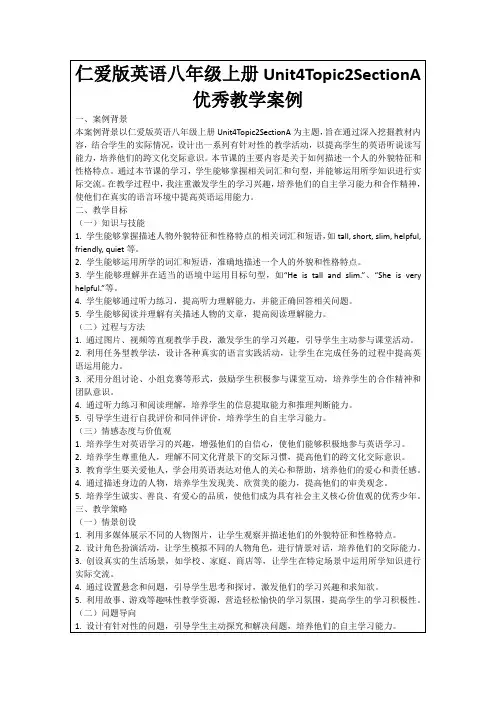
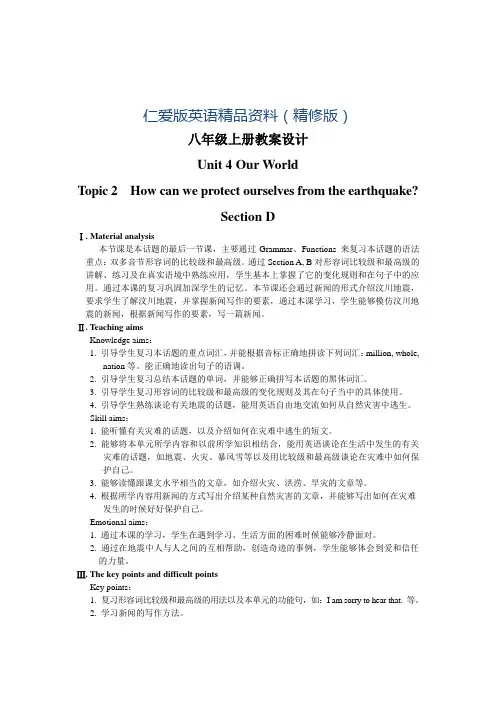
仁爱版英语精品资料(精修版)八年级上册教案设计Unit 4 Our WorldTopic 2 How can we protect ourselves from the earthquake?Section DⅠ. Material analysis本节课是本话题的最后一节课,主要通过Grammar、Functions 来复习本话题的语法重点:双多音节形容词的比较级和最高级。
通过Section A, B对形容词比较级和最高级的讲解、练习及在真实语境中熟练应用,学生基本上掌握了它的变化规则和在句子中的应用。
通过本课的复习巩固加深学生的记忆。
本节课还会通过新闻的形式介绍汶川地震,要求学生了解汶川地震,并掌握新闻写作的要素,通过本课学习,学生能够模仿汶川地震的新闻,根据新闻写作的要素,写一篇新闻。
Ⅱ. Teaching aimsKnowledge aims:1. 引导学生复习本话题的重点词汇,并能根据音标正确地拼读下列词汇:million, whole,nation等。
能正确地读出句子的语调。
2. 引导学生复习总结本话题的单词,并能够正确拼写本话题的黑体词汇。
3. 引导学生复习形容词的比较级和最高级的变化规则及其在句子当中的具体使用。
4. 引导学生熟练谈论有关地震的话题,能用英语自由地交流如何从自然灾害中逃生。
Skill aims:1. 能听懂有关灾难的话题,以及介绍如何在灾难中逃生的短文。
2. 能够将本单元所学内容和以前所学知识相结合,能用英语谈论在生活中发生的有关灾难的话题,如地震、火灾、暴风雪等以及用比较级和最高级谈论在灾难中如何保护自己。
3. 能够读懂跟课文水平相当的文章,如介绍火灾、洪涝、旱灾的文章等。
4. 根据所学内容用新闻的方式写出介绍某种自然灾害的文章,并能够写出如何在灾难发生的时候好好保护自己。
Emotional aims:1. 通过本课的学习,学生在遇到学习、生活方面的困难时候能够冷静面对。
Unit 4 Topic 2 Section D
1.Here is the news. 倒装句。
news为不可数名词
2.at 2:28 in the afternoon, on May 12,2008
时间介词in,on at用法:
年月季节早晚in,at午夜时与分,
具体某日上下午,星期日期全用on.
3.happen为偶然发生,无被动,
常用句子:What happened to you ?
happen to do sth 碰巧做某事
4.more than = over 超过less than 少于
5.five million 五百万millions of 成百万
6.lost one’s homes 失去某人的家园
2.f all down 落下;摔倒;倒塌fall----fell
7.w ith the help of sb =with one’s help
在某人的帮助下
8.the whole nation =all the nation 整个民族
9.rebuild their homes 重建他们的家园
10.return to normal life 返回正常的生活
live /have a normal life 过着正常的生活
11.be able to do sth 能够做某事有人称和数的变化
can无人称和数的变化
be able to用于各种时态,can只能用于一般现在时或一般过去时。
12.over again 再次。
八年级上册教案设计
Unit 4 Our World
Topic 2 How can we protect ourselves from the earthquake?
Section D
Ⅰ. Material analysis
本节课是本话题的最后一节课,主要通过Grammar、Functions 来复习本话题的语法重点:双多音节形容词的比较级和最高级。
通过Section A, B对形容词比较级和最高级的讲解、练习及在真实语境中熟练应用,学生基本上掌握了它的变化规则和在句子中的应用。
通过本课的复习巩固加深学生的记忆。
本节课还会通过新闻的形式介绍汶川地震,要求学生了解汶川地震,并掌握新闻写作的要素,通过本课学习,学生能够模仿汶川地震的新闻,根据新闻写作的要素,写一篇新闻。
Ⅱ. Teaching aims
Knowledge aims:
1. 引导学生复习本话题的重点词汇,并能根据音标正确地拼读下列词汇:million, whole,
nation等。
能正确地读出句子的语调。
2. 引导学生复习总结本话题的单词,并能够正确拼写本话题的黑体词汇。
3. 引导学生复习形容词的比较级和最高级的变化规则及其在句子当中的具体使用。
4. 引导学生熟练谈论有关地震的话题,能用英语自由地交流
如何从自然灾害中逃生。
Skill aims:
1. 能听懂有关灾难的话题,以及介绍如何在灾难中逃生的短文。
2. 能够将本单元所学内容和以前所学知识相结合,能用英语谈
论在生活中发生的有关灾难的话题,如地震、火灾、暴风雪等以及用比较级和最高级谈论在灾难中如何保护自己。
3. 能够读懂跟课文水平相当的文章,如介绍火灾、洪涝、旱灾的文章等。
4. 根据所学内容用新闻的方式写出介绍某种自然灾害的文章,并能够写出如何在灾难
发生的时候好好保护自己。
Emotional aims:
1. 通过本课的学习,学生在遇到学习、生活方面的困难时候能够冷静面对。
2. 通过了解在地震中人与人之间的互相帮助,创造奇迹的事
例,学生能够体会到爱和信任的力量。
Ⅲ. The key points and difficult points
Key points:
1. 复习形容词比较级和最高级的用法以及本单元的功能句,如:I am sorry to hear that. 等。
2. 学习新闻的写作方法。
Difficult points:
根据新闻的要素写新闻。
Ⅳ. Learning strategies
1. 在看新闻的时候注意新闻的特点,可以帮助我们写出标准的新闻。
2. 在读到有关自然灾害的文章的时候,试着将它翻译成英文,哪怕见一次翻译一句都
能提高我们的英语水平。
Ⅴ. Teaching aids
Computer multimedia projector,postcards
Ⅵ. Teaching procedures
Ⅶ. Blackboard design。